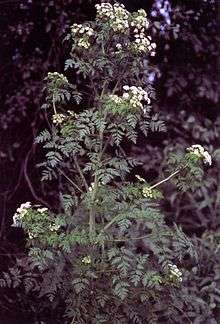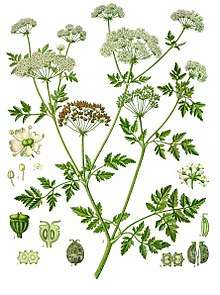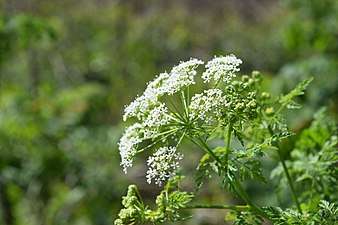Conium maculatum
| Conium maculatum | |
|---|---|
 | |
| Conium maculatum in California | |
| Scientific classification | |
| Kingdom: | Plantae |
| Clade: | Angiosperms |
| Clade: | Eudicots |
| Clade: | Asterids |
| Order: | Apiales |
| Family: | Apiaceae |
| Genus: | Conium |
| Species: | C. maculatum |
| Binomial name | |
| Conium maculatum L., 1753 | |
| Synonyms[1] | |
|
List
| |

| Wikimedia Commons has media related to Conium maculatum. |
Conium maculatum, the hemlock or poison hemlock, is a highly poisonous biennial herbaceous flowering plant in the carrot family Apiaceae, native to Europe and North Africa. A hardy plant capable of living in a variety of environments, hemlock is widely naturalized in locations outside its native range.
Name
Conium maculatum is known by several common names. In addition to the English hemlock, the Australian carrot fern[2] and the Irish devil's bread or devil's porridge, the following names are also used: poison parsley, spotted corobane and spotted hemlock.
The plant should not be confused with the coniferous tree Tsuga, also known by the common name hemlock, even though the two plants are quite different. Similarly, the plant should not be confused with Cicuta (commonly known as water hemlock). The dried stems are sometimes called kecksies or kex.[3]
Conium comes from the Ancient Greek κώνειον - kṓneion : "hemlock". This may be related to konas (meaning to whirl), in reference to vertigo, one of the symptoms of ingesting the plant.[4]
Description
Conium maculatum is an herbaceous biennial flowering plant that grows to 1.5–2.5 m (5–8 ft) tall, with a smooth, green, hollow stem, usually spotted or streaked with red or purple on the lower half of the stem. All parts of the plant are hairless (glabrous); the leaves are two- to four-pinnate, finely divided and lacy, overall triangular in shape, up to 50 cm (20 in) long and 40 cm (16 in) broad.[5] It has been introduced and naturalised in many other areas, including Asia, North America, Australia and New Zealand.[6][7][2] The plant is often found in poorly drained soil, particularly near streams, ditches and other watery surfaces. It also appears on roadsides, edges of cultivated fields and waste areas[6] and is considered an invasive species in 12 U.S. states.[8]
Conium maculatum grows in damp areas,[9] but also on drier rough grassland, roadsides and disturbed ground. It is used as a food plant by the larvae of some Lepidoptera species, including silver-ground carpet. The poison hemlock moth (Agonopterix alstroemeriana) feeds on the plant during its larval stage. A. alstroemeriana has been widely used as a biological control agent for C. maculatum.[10] Poison hemlock flourishes in the spring, when most other forage is gone. All plant parts are poisonous, but once the plant is dried, the poison is greatly reduced, although not gone completely.
Toxicity
-Coniine_Structural_Formula_V.1.svg.png)
The plant is poisonous to animals that graze on it.
Conium and other alkaloid toxins
Conium contains the piperidine alkaloids coniine, N-methylconiine, conhydrine, pseudoconhydrine and gamma-coniceine (or g-coniceïne), which is the precursor of the other hemlock alkaloids.[6][12][13][14]
Coniine has a chemical structure and pharmacological properties similar to that of nicotine.[6][15] Coniine acts directly on the central nervous system through inhibitory action on nicotinic acetylcholine receptors. In high enough concentrations, coniine can be dangerous to humans and livestock.[13] With its high potency, the ingestion of seemingly small doses can easily result in respiratory collapse and death.[16]
Coniine also has significant toxic effects on the kidneys. The presence of rhabdomyolysis and acute tubular necrosis has been shown in patients who died from hemlock poisoning. A fraction of these patients were also found to have acute renal failure.[17]
Toxicology
In a short time, the alkaloids produce a potentially fatal neuromuscular blockage when the respiratory muscles are affected. Acute toxicity, if not lethal, may resolve in the spontaneous recovery of the affected animals provided further exposure is avoided.
The onset of symptoms is similar to that caused by curare, with an ascending muscular paralysis leading to paralysis of the respiratory muscles, causing death from oxygen deprivation. Death can be prevented by artificial ventilation until the effects have worn off 48–72 hours later.[6] For an adult, the ingestion of more than 100 mg (0.1 gram) of coniine (about six to eight fresh leaves, or a smaller dose of the seeds or root) may be fatal.[18]
It has been observed that poisoned animals tend to return to feed on the plant. Chronic toxicity affects only pregnant animals; when they are poisoned by C. maculatum during the fetus' organ-formation period, the offspring is born with malformations, mainly palatoschisis and multiple congenital contractures (arthrogryposis). Chronic toxicity is irreversible; though arthrogryposis may be surgically corrected in some cases, most of the malformed animals die. Such losses may be underestimated, at least in some regions, because of the difficulty in associating malformations with the much earlier maternal poisoning.
Since no specific antidote is available, prevention is the only way to deal with the production losses caused by the plant. Control with herbicides and grazing with less-susceptible animals (such as sheep) have been suggested. C. maculatum alkaloids can enter the human food chain via milk and fowl.
Historical and cultural references
Conium maculatum is the plant that killed Theramenes, Socrates and Phocion.[19] In ancient Greece, hemlock was used to poison condemned prisoners. Socrates, the most famous victim of hemlock poisoning, was accused of impiety and corrupting the young men of Athens in 399 BC, and his trial resulted in a death sentence. Although Socrates could have avoided death, he decided to take a potent infusion of the hemlock plant. Plato described Socrates' death in the Phaedo:[20]
The man...laid his hands on him and after a while examined his feet and legs, then pinched his foot hard and asked if he felt it. He said "No"; then after that, his thighs; and passing upwards in this way he showed us that he was growing cold and rigid. And then again he touched him and said that when it reached his heart, he would be gone. The chill had now reached the region about the groin, and uncovering his face, which had been covered, he said – and these were his last words – "Crito, we owe a cock to Asclepius. Pay it and do not neglect it." "That," said Crito, "shall be done; but see if you have anything else to say." To this question he made no reply, but after a little while he moved; the attendant uncovered him; his eyes were fixed. And Crito when he saw it, closed his mouth and eyes.[21]
Although many have questioned whether this is a factual account, it is the perspective of Bloch that careful attention to Plato's words, modern and ancient medicine and other ancient Greek sources point to this account being consistent with Conium poisoning.[22]
 Poison Hemlock
Poison Hemlock Conium Maculatum in Chino, California, on March 10, 2017
Conium Maculatum in Chino, California, on March 10, 2017 Hemlock seed heads in late summer
Hemlock seed heads in late summer The Death of Socrates, by Jacques-Louis David (1787)
The Death of Socrates, by Jacques-Louis David (1787)
See also
References
- ↑ Allkin, R.; Magill, R.; et al., eds. (2013). "Conium maculatum" (online database). The Plant List. vs. 1.1. St. Louis, MO: Missouri Botanical Garden. Retrieved January 23, 2017 – via theplantlist.org.
- 1 2 Atlas of Living Australia, Conium maculatum L., Carrot Fern
- ↑ "Kex". EtymOnline.
- ↑ "Conium maculatum". Northwestern Arizona University. Retrieved 2012-07-06.
- ↑ Altervista Flora Italiana, Cicuta maggiore, Conium maculatum L. includes photos and European distribution map
- 1 2 3 4 5 Schep, L. J.; Slaughter, R. J.; Beasley, D. M. (2009). "Nicotinic Plant Poisoning". Clinical Toxicology. 47 (8): 771–781. doi:10.1080/15563650903252186. PMID 19778187.
- ↑ Zehui, Pan & Watson, Mark F. (January 23, 2017). "31. Conium Linnaeus, Sp. Pl. 1: 243. 1753, 船尾, du shen shu". Flora of China. Retrieved January 23, 2017. See also the substituent page on Conium maculatum.
- ↑ "poison hemlock, spotted hemlock – Conium maculatum". Map, where regarded invasive. National Park Service. Retrieved 2009-01-14.
- ↑ Online Atlast of the British and Irish Flora: Conium Maculatum
- ↑ Castells, Eva; Berenbaum, May R. (June 2006). "Laboratory Rearing of Agonopterix alstroemeriana, the Defoliating Poison Hemlock (Conium maculatum L.) Moth, and Effects of Piperidine Alkaloids on Preference and Performance". Environmental Entomology. Entomological Society of America. 35: 607–615. doi:10.1603/0046-225x-35.3.607 – via ResearchGate.
- ↑ Stephen T. Lee; Benedict T. Green; Kevin D. Welch; James A. Pfister; Kip E. Panter (2008). "Stereoselective potencies and relative toxicities of coniine enantiomers". Chemical Research in Toxicology. 21 (10): 2061–2064. doi:10.1021/tx800229w.
- ↑ Reynolds, T. (June 2005). "Hemlock Alkaloids from Socrates to Poison Aloes". Phytochemistry. 66 (12): 1399–1406. doi:10.1016/j.phytochem.2005.04.039. PMID 15955542.
- 1 2 Vetter, J. (September 2004). "Poison Hemlock (Conium maculatum L.)". Food and Chemical Toxicology. 42 (9): 1373–1382. doi:10.1016/j.fct.2004.04.009. PMID 15234067.
- ↑ "Conium maculatum TOXINZ - Poisons Information". www.toxinz.com. Retrieved 2017-05-29.
- ↑ Brooks, D. E. (2010-06-28). "Plant Poisoning, Hemlock". MedScape. eMedicine. Retrieved 2012-03-02.
- ↑ Tilford, Gregory L. Edible and Medicinal Plants of the West. ISBN 0-87842-359-1.
- ↑ Note:acute tubulr necrosis causes acute renal failureRizzi, D; Basile, C; Di Maggio, A; et al. (1991). "Clinical spectrum of accidental hemlock poisoning: neurotoxic manifestations, rhabdomyolysis and acute tubular necrosis. L.". Nephrol. Dial. Transplant. 6 (12): 939–43. doi:10.1093/ndt/6.12.939. PMID 1798593.
- ↑ "Conium maculatum L." Inchem. IPCS (International Programme on Chemical Safety). Retrieved 2012-07-06.
- ↑ Blamey, M.; Fitter, R.; Fitter, A (2003). Wild flowers of Britain and Ireland: The Complete Guide to the British and Irish Flora. London: A & C Black. ISBN 978-1408179505.
- ↑ "Plato, Euthyphro, Apology, Crito, Phaedo". Retrieved 2012-07-06.
- ↑ Plato, Phaedo 117e–118a. Translated by Loeb Classical Library (1990 ed.). Cambridge, Massachusetts: Harvard University Press. pp. 401–3.
- ↑ Bloch, E. (March 2001). "Hemlock Poisoning and the Death of Socrates: Did Plato Tell the Truth?". Journal of the International Plato Society (1). Archived from the original on 2017-04-07. —A version of this article was also printed in Bloch, E. (2001). Brickhouse, Thomas C.; Smith, Nicholas D., eds. The Trial and Execution of Socrates: Sources and Controversies. New York: Oxford University Press. ISBN 978-0-19-511980-0.
External links
| Wikisource has the text of the 1905 New International Encyclopedia article Hemlock. |
- "Conium". Flora Europaea. Royal Botanic Garden Edinburgh.
| Wikimedia Commons has media related to Conium maculatum (Hemlock). |